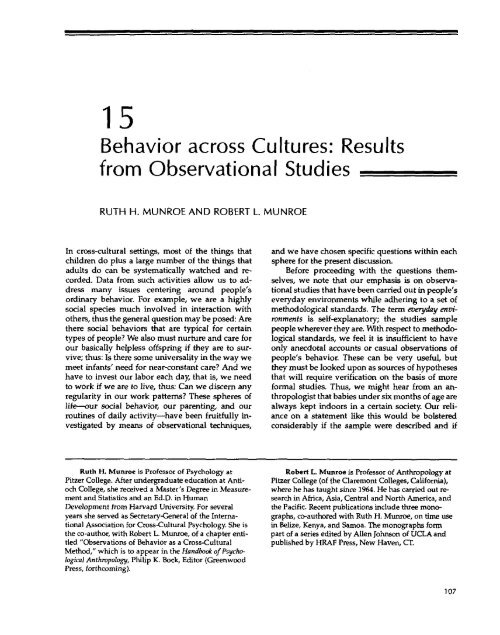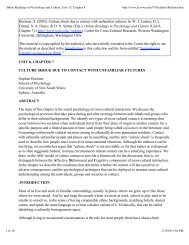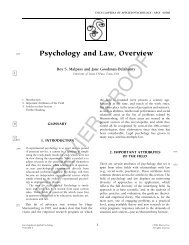Behavior across Cultures: Results from Observational Studies
Behavior across Cultures: Results from Observational Studies
Behavior across Cultures: Results from Observational Studies
Create successful ePaper yourself
Turn your PDF publications into a flip-book with our unique Google optimized e-Paper software.
<strong>Behavior</strong> <strong>across</strong> <strong>Cultures</strong>: <strong>Results</strong><br />
<strong>from</strong> <strong>Observational</strong> <strong>Studies</strong><br />
RUTH H. MUNROE AND ROBERT L. MUNROE<br />
In cross-cultural settings, most of the things that<br />
children do plus a large number of the things that<br />
adults do can be systematically watched and recorded.<br />
Data <strong>from</strong> such activities allow us to address<br />
many issues centering around people's<br />
ordinary behavior. For example, we are a highly<br />
social species much involved in interaction with<br />
others, thus the general question may be posed; Are<br />
there social behaviors that are typical for certain<br />
types of people? We also must nurture and care for<br />
our basically helpless offspring if they are to survive;<br />
thus: Is there some universality in the way we<br />
meet infants' need for near-constant care? And we<br />
have to invest our labor each day, that is, we need<br />
to work if we are to live, thus: Can we discern any<br />
regularity in our work patterns? These spheres of<br />
life-our social behavior, our parenting, and our<br />
routines of daily activity-have been fruitfully investigated<br />
by means of observational techniques,<br />
and we have chosen specific questions within each<br />
sphere for the present discussion.<br />
Before proceeding with the questions themselves,<br />
we note that our emphasis is on observational<br />
studies that have been carried out in people's<br />
everyday environments while adhering to a set of<br />
methodological standards. The term everyday enuironments<br />
is self-explanatory; the studies sample<br />
people wherever they are. With respect to methodological<br />
standards, we feel it is insufficient to have<br />
only anecdotal accounts or casual observations of<br />
people's behavior. These can be very useful, but<br />
they must be looked upon as sources of hypotheses<br />
that will require verification on the basis of more<br />
formal studies. Thus, we might hear <strong>from</strong> an anthropologist<br />
that babies under six months of age are<br />
always kept indoors in a certain society. Our reliance<br />
on a statement like this would be bolstered<br />
considerably if the sample were described and if<br />
Ruth H. Munroe is Professor of Psychology at<br />
Pitzer College. After undergraduate education at Antioch<br />
College, she received a Master's Degree in Measurement<br />
and Statistics and an Ed.D. in Human<br />
Development <strong>from</strong> Harvard University. For several<br />
years she served as Secretary-General of the International<br />
Association for Cross-Cultural Psychology. She is<br />
the co-author, with Robert L. Munroe, of a chapter entitled<br />
"Observations of <strong>Behavior</strong> as a Cross-Cultural<br />
Method," which is to appear in the Handbook of Psychological<br />
Anthropology, Philip K. Bock, Editor (Greenwood<br />
Press, forthcoming).<br />
Robert L. Munroe is Professor of Anthropology at<br />
Pitzer College (of the Claremont Colleges, California),<br />
where he has taught since 1964. He has carried out research<br />
in Africa, Asia, Central and North America, and<br />
the Pacific. Recent publications include three monographs,<br />
co-authored with Ruth H. Munroe, on time use<br />
in Belize, Kenya, and Samoa. The monographs form<br />
part of a series edited by Allen Johnson of UCLA and<br />
published by HRAF Press, New Haven, CT.
108 15/<strong>Behavior</strong> <strong>across</strong> <strong>Cultures</strong>: <strong>Results</strong> <strong>from</strong> <strong>Observational</strong> <strong>Studies</strong><br />
observers had been trained and had achieved reliability<br />
using a standardized observation technique<br />
and schedule. In other words, if a general statement<br />
is made, we want not simply a flat assertion but<br />
also a detailed specification of the means used to<br />
derive it. So, keeping these methodological considerations<br />
in mind, we can now turn to the three<br />
representative question-sets and some partial empirical<br />
answers.<br />
Question 1: Are boys everywhere more aggressive<br />
than girls? If such a sex difference exists, does it hold<br />
<strong>across</strong> all types of aggression? Aggression is of special<br />
interest as a form of social behavior both because it<br />
is frequently associated with males and because its<br />
range runs <strong>from</strong> children's mild attacks to full-scale<br />
warfare. Although aggression has been among the<br />
most widely studied topics in all of psychology,<br />
relatively little of the research has been based on the<br />
systematic observation of children and on standardized<br />
definitions for aggressive behavior. We<br />
want to report briefly on these kinds of data, which<br />
have been gathered <strong>from</strong> ten societies around the<br />
world, including most of the major culture areas.<br />
Children aged 3 to 11 were studied in their homes<br />
and communities as they engaged in normal social<br />
activities with others, nurturing, scolding, helping,<br />
and hitting-in short, doing those things that<br />
youngsters typically do. Several thousand behavioral<br />
acts were observed and coded according to<br />
the categories of social behavior into which the<br />
acts fell. The categories included three types of aggression:<br />
physical assault, rough-and-tumble play,<br />
and verbal attack such as insulting, threatening, or<br />
challenging. As Table 1 indicates, a very strong preponderance<br />
of aggressive acts was displayed by<br />
boys. The last column in the table, which gives<br />
overall tendencies, shows that in no group did the<br />
girls display a higher level of total agonistic behavior<br />
than boys, even though there were two societies<br />
in which boys and girls were equal. (One of these<br />
semi-exceptional cases, interestingly enough, was<br />
the United States, which had formed the basis for<br />
the original generalization!) For each type of aggressive<br />
behavior considered separately, as we see<br />
in the first three columns, only one society in ten<br />
showed the girls to be higher than the boys. For<br />
verbal aggression, however, there were enough<br />
"ties" that just six of the ten societies had a higher<br />
level for boys than girls. Based on our data, then,<br />
we can say in answer to our initial question-set,<br />
first, that boys do seem to aggress more frequently<br />
than girls <strong>across</strong> a wide variety of cultures; and<br />
second, that while the subcategories of aggression<br />
also tend to show boys to be higher than girls, the<br />
cross-cultural tendency is relatively weak so far as<br />
verbal aggression is concerned. In general, this<br />
rough cross-cultural count mirrors quite well the<br />
usual Western-based finding, with boys almost always<br />
more frequently observed in the physical<br />
forms of aggression, but with girls not far behind in<br />
verbal aggression, and sometimes rivaling boys in<br />
that respect.<br />
Question 2: Are females always the main caretakers<br />
of children? Don't fathers ever match mothers in this<br />
regard, or at least get themselves heavily involved in<br />
caretaking activities? Females are the main caretakers<br />
TABLE 1<br />
Sex differences in aggression in 10 societies<br />
Type of Aggression<br />
Society" Assaultine Horseolav Verbal All<br />
Belize<br />
India<br />
Kenya (a)<br />
Kenya (b)<br />
Mexico<br />
Nepal<br />
Okinawa<br />
Philippines<br />
Samoa<br />
U.S.A.<br />
+" indicates that boys' scores were higher than girls'.<br />
"-" indicates that girls' scores were higher than boys'.<br />
=" indicates that boys' and girls' scores were approximately equal.<br />
"Data for Belize, Kenya (b), Nepal, and Samoa were taken <strong>from</strong> Munroe and Munroe<br />
(1984). Data for India, Kenya (a), Mexico, Okinawa, the Philippines, and the U.S.A.<br />
were taken <strong>from</strong> Whiting and Edwards (1973).
15/<strong>Behavior</strong> <strong>across</strong> <strong>Cultures</strong>: <strong>Results</strong> <strong>from</strong> <strong>Observational</strong> <strong>Studies</strong> 109<br />
of infants and young children in all known cultures.<br />
Available ethnographic evidence over the years led<br />
anthropologists to claim this, and subsequent observational<br />
studies have corroborated it. As to fathers,<br />
their involvement in caretaking does vary<br />
culturally, but it has always been reported as very<br />
low compared with that of mothers. Direct observation<br />
has, again, confirmed this point, with mothers<br />
found involved in direct care of infants about 20-25<br />
percent of their time, fathers no more than 2-3 percent.<br />
This wide gap between mothers and fathers<br />
has prompted many speculations, including the<br />
possibility of a maternal instinct and a division of<br />
These results lay to rest any<br />
supposition that adult males may<br />
be fundamentally disinclined to<br />
undertake intensive caretaking or<br />
nurturing behavior.<br />
labor based on physical characteristics, such as size<br />
and strength, that differentiate the sexes in all societies.<br />
The findings of a recent observational project,<br />
however, have demonstrated that an extreme cultural<br />
instance can cause us to revise our ideas about<br />
what might seem to be natural behavior. Anthropologist<br />
Barry Hewlett (1991) lived with and studied<br />
the Aka Pygmies of the Western Congo Basin.<br />
He had noted, casually, that fathers were highly<br />
involved in infant care. He then carried out several<br />
hundred hours of systematic observations and, on<br />
that basis, reported that: fathers averaged a full<br />
hour per day holding the baby during daylight<br />
hours, spent 20 percent of their time in early evenings<br />
actively caring for the baby, were found no<br />
farther than an arm's length <strong>from</strong> their babies for<br />
half the day, and, in the Aka's forest-camp setting,<br />
were within view of the baby a remarkable 88 percent<br />
of the time. (Even with this level of involvement,<br />
father care of the Aka infant was below that<br />
of the mother.) These results lay to rest any supposition<br />
that adult males may be fundamentally disinclined<br />
to undertake intensive caretaking or<br />
nurturing behavior. Hewlett also found that Aka<br />
fathers, though intimate, affectionate, and helpful<br />
with their infants, did not engage in vigorous or<br />
rough-and-tumble play. His data clearly do not support<br />
the recent idea that infants become attached to<br />
their fathers by means of father-initiated stimulating<br />
play. But to return to our question, we have in<br />
the Aka case a level of paternal care far exceeding<br />
anything hitherto reported. As in other societies,<br />
the Aka father's caretaking does not match that of<br />
the mother, but involvement with his baby is very<br />
high indeed.<br />
Question 3: Does leisure time increase with modem<br />
urban life? Or is it in the technologically and economically<br />
simpler societies that people have time to spare? At<br />
mid-century, the consensus was that the Western<br />
world possessed a technical competency capable of<br />
granting us all the leisure we might want. It was<br />
argued that <strong>from</strong> the perspective of a hunter-gatherer<br />
like the Tasmanian, "we apparently had a<br />
magic which made the plants grow as abundantly<br />
as we wanted and the animals herd together as<br />
tame as dogs. . . ready to be slaughtered at will"<br />
(Forde, 1952, p. 2). And for their part, hunters were<br />
considered to be "threatened with starvation and<br />
working constantly to achieve bare survival" (Netting,<br />
1977, p. 9). But this traditional view was completely<br />
reversed when the first systematic<br />
observations on time use among hunters began to<br />
be collected. The food quest, as among the !Kung<br />
Bushmen, occupied adults only a few hours per day<br />
on average, and foragers were suddenly rechri<br />
tened "the original affluent society," with industrial<br />
peoples said to work longer and harder than all<br />
others.<br />
Now, however, behavior observations have<br />
been extended to societies at all levels of cultural<br />
complexity and in many areas of the world, and we<br />
are able to answer the question of relative work and<br />
leisure in a more precise way. We note first, though,<br />
that the term "labor" is used more inclusively than<br />
for just subsistence activity and includes work as<br />
broadly defined, namely, the wage jobs most of us<br />
engage in, our household chores, the shopping, the<br />
preparation of food, active caretaking of children,<br />
and so on. It appears, contrary both to the earlier<br />
view and to the more recent one, that we in the<br />
urban-industrial world put in approximately the<br />
same time on daily labor as those in food-collecting<br />
societies. Yet lying between us and the hunting peoples<br />
on a scale of cultural complexity are the agrarian<br />
societies, and what we have learned <strong>from</strong><br />
observation is that these agriculturalists work<br />
longer hours than either us or the hunter-gatherers.<br />
Not only adults but children too follow this pattern;<br />
one comparison, for example, showed that during<br />
nonschool hours for children aged 3-10, those in
110 15/ <strong>Behavior</strong> <strong>across</strong> <strong>Cultures</strong>: <strong>Results</strong> <strong>from</strong> <strong>Observational</strong> <strong>Studies</strong><br />
farming communities were engaged in work more<br />
than 20 percent of the time, while U.S. and !Kung<br />
Bushmen children spent just 5 percent or less of<br />
their time working. We may ask why it is that the<br />
farmers stay busier than other peoples. Although<br />
the reasons are not known with any certainty, we<br />
can point to two classes of activities to which farmers<br />
must devote considerable time, whereas only<br />
one of them is performed steadily by hunter-gatherers,<br />
and only the other by us in the urban-industrial<br />
world. Farmers, and ourselves, spend a good<br />
deal of time doing chores, for instance, food preparation<br />
and storage, housekeeping, purchasing and<br />
taking care of material goods, laundering clothes,<br />
and so forth; but hunter-gatherers, who accumulate<br />
but minimal property, are spared much of this effort.<br />
Farmers also must dedicate time to subsistence<br />
labor, an activity in which they are joined by<br />
hunter-gatherers, but not by us, since we have specialists<br />
(farmers, ranchers, fishermen) whom we<br />
pay to do this work. So agriculturalists seem to be<br />
kept busy on both fronts, and we and the hunting<br />
peoples are seriously engaged in only one of these<br />
time-consuming activities. Whatever the reasons<br />
for agrarian industriousness, though, the surprise<br />
has been that as we observe work activities in<br />
societies varying sharply on the scale of cultural<br />
complexity, we do not find time-use patterns developing<br />
in a simple linear fashion.<br />
Besides demonstrating the usefulness of observational<br />
research, each of the above sets of studies<br />
also illustrates the value of cross-cultural investigation<br />
generally (cf. Whiting, 1968). The findings on<br />
childhood aggression have helped us answer the<br />
question of whether a sex difference in Westembased<br />
findings was culture-specific or held up<br />
among people in general. The study of infant care<br />
among Aka fathers has enabled us to extend the<br />
range of known behavior; that is, it has discovered<br />
a set of behaviors that were normative in one culture<br />
even though exhibited by few or no individuals<br />
in other cultures. And the issue of labor and<br />
cultural complexity has posed a question that was<br />
cross-cultural in its very formulation, requiring<br />
data <strong>from</strong> several different types of societies if any<br />
findings were to be generated. Thus a cross-cultural<br />
perspective has enhanced the contribution of all the<br />
sets of studies we have considered.<br />
We noted above that a host of topics are open to<br />
study by observational techniques. For instance,<br />
many who work in Third World countries believe<br />
that young children should be fed five small meals<br />
a day. Although we may question the need for ex-<br />
actly five periods of food intake every day, the<br />
broader point is that children are more likely to<br />
achieve proper physiological development if they<br />
eat frequently. Implicit in such beliefs is the idea<br />
that children should and do eat more frequently<br />
than adults. As it happens, we can easily find out<br />
whether cross-culturally, under naturalistic conditions,<br />
this hypothesis receives support. Allen<br />
Johnson of UCLA has inaugurated a cooperative<br />
venture involving the publication, by the Human<br />
Relations Area Files, of a collection of standardized<br />
time-use databases. Now available for a total of<br />
eight societies ranging over several continents, the<br />
databases can be rapidly consulted to ask whether<br />
children do in fact eat and drink more frequently<br />
than adults. And the answer is yes, they are so<br />
engaged. For a total of twelve possible comparisons<br />
(youths vs. adults, toddlers vs. adults, etc.) for<br />
which such data were presented, every single one<br />
showed more time invested in eating by the<br />
younger groups than by the adults.<br />
The great number of observational studies have<br />
focused on cultural patterns rather than individual<br />
differences, and on gross behavioral categories<br />
(e.e.. infant care, labor) rather than micro-level be-<br />
~ ".<br />
havior. But the varied approaches to observational<br />
research in standard psychological study (cf. Weick,<br />
1985) might lead us tosuspkt that these previous<br />
foci are not the only bases on which cross-cultural<br />
behavioral observation can be founded. One recent<br />
cross-cultural study, for instance, compared fatherabsent<br />
boys with father-present boys, and the dependent<br />
measure was eye-gaze, the issue being<br />
whether in natural settings the father-absent boys<br />
paid more attention or less attention to males in<br />
their social environments. It turned out that fatherabsent<br />
boys looked more frequently at males, perhaps<br />
in unconscious compensation for the fact that<br />
they did not regularly have an adult male model in<br />
the home. (The attention of girls to males was unrelated<br />
to father absence in these samples.) Approaches<br />
of this sort, with a concentration on<br />
individual differences and molecular levels of behavior,<br />
can provide data that are complementary to<br />
traditional observational research in cross-cultural<br />
settings.<br />
LIMITATIONS<br />
The more sensitive and private aspects of people's<br />
lives are essentially off-limits to observational research.<br />
Observation-based inquiry is also not the
15/ <strong>Behavior</strong> <strong>across</strong> <strong>Cultures</strong>: <strong>Results</strong> <strong>from</strong> <strong>Observational</strong> <strong>Studies</strong> 11 1<br />
optimal choice, and certainly not the only choice,<br />
for the study of cognition, emotion, fantasy, and<br />
numerous other "internal" phenomena. Nevertheless,<br />
the study of overt behavior can be integrated<br />
with a great variety of methodologies in order to<br />
ferret out underlying processes. Regarding the<br />
higher rate of aggression among boys, for instance,<br />
we could bring to bear both physiological research<br />
and the investigation of relevant predispositions<br />
and circumstances, including impulsivity levels,<br />
the availability and importance of particular role<br />
models, socialization techniques, and interests. And<br />
although we were willing to speculate above as to<br />
the reason that father absence was associated with<br />
over-gazing at males, we obviously cannot talk<br />
with assurance about "unconscious" motivation<br />
unless something besides behavioral data can be<br />
mustered. So the contributions of observational research<br />
will undoubtedly be enhanced as they are<br />
incorporated into a larger, more unified effort to<br />
account for human behavior. In the meantime, we<br />
hope that the examples given in this brief presentation<br />
have helped make clear the usefulness of behavior<br />
observation as a tool for cross-cultural<br />
studies.<br />
REFERENCES<br />
-<br />
Forde, C. D. (1952). Habitat, economy and society. London:<br />
Methuen.<br />
Hewlett, B. S. (1991). Intimate fathers: The nature and context<br />
of Aka Pygmy paternal infant care. Ann Arbor:<br />
University of Michigan Press.<br />
MU NO^, R. L., & Munroe, R. H. (1984, November). Aggression<br />
among children: Predictors and correlates in four<br />
societies. Paper presented at the annual meeting of<br />
the American Anthropological Association, Denver.<br />
Netting, R. McC. (1977). Cultural ecology. Medo Park, CA:<br />
Cummings.<br />
Weick, K. E. (1985). Systematic observational methods. In<br />
G. Lindzey & E. Aronson (Eds.), The handbook of social<br />
psychology (3rd ed.) (Vol. 1, pp. 567-634). New York:<br />
Random House.<br />
Whiting, B., & Edwards, C. l? (1973). A cross-cultural<br />
analysis of sex differences in the behavior of children<br />
aged 3-11. Journal of Social Psychology, 91,171-188.<br />
Whiting, J. W. M. (1968). Methods and problems in crosscultural<br />
research. In G. Lindzey & E. Aronson (Eds.),<br />
The handbook of social psychology (2d ed.) (Vol. 2, pp.<br />
693-728). Reading, MA: Addison-Wesley.







